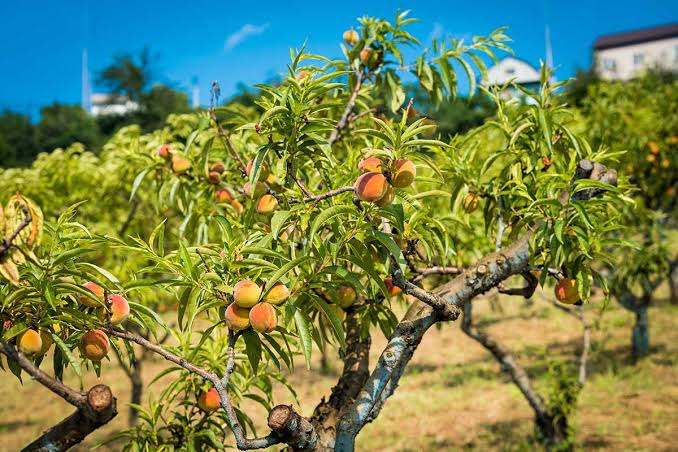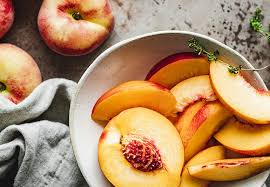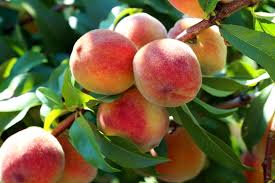Peaches are delicious fruits that many people enjoy eating. They come in various colors, such as yellow and white, and have a soft, fuzzy skin. These fruits are not only tasty but also packed with nutrients that are good for your body.
When you bite into a ripe peach, you experience a burst of sweetness and juiciness. The flavor is so delightful that it can instantly lift your mood. Peaches are often eaten fresh, but they can also be used in various recipes, from pies and cobblers to salads and smoothies.
One remarkable thing about peaches is their nutritional value. They contain vitamins like vitamin C, which is essential for a healthy immune system, and vitamin A, which is good for your eyes. Peaches also provide fiber, aiding in digestion and keeping your stomach happy.
Growing peaches involves patience as they require the right climate and care. These fruits thrive in warm, sunny conditions and well-drained soil. Farmers carefully tend to peach orchards, ensuring that the trees receive adequate water and nutrients to produce the best-tasting fruit.
Peach trees bloom with beautiful flowers in the spring, creating a picturesque scene. As the season progresses, these blossoms transform into small, green peaches that gradually grow and ripen under the sun’s warmth. The process from blossom to ripe fruit is a testament to nature’s wonders.
In addition to being tasty and nutritious, peaches have a cultural significance. They are often associated with summertime and are a popular ingredient in many traditional dishes worldwide. From Asian cuisines to European desserts, peaches have found their way into diverse culinary traditions, enriching the global tapestry of flavors.
Peach festivals are celebrated in some regions, where people come together to enjoy this delightful fruit in various forms. Whether you prefer biting into a fresh, juicy peach or savoring it as part of a delectable dessert, there’s something undeniably special about the experience of enjoying peaches.
Peaches are more than just fruits; they are a celebration of flavor, nutrition, and nature’s beauty. From the orchard to your plate, the journey of a peach is a testament to the wonders of agriculture and the simple joys that nature provides. So, the next time you bite into a peach, savor not only its sweetness but also the rich story behind this delightful fruit.
Peaches are not only cherished for their taste and nutritional benefits but also for their versatility. They can be enjoyed in numerous culinary creations, showcasing their adaptability in both sweet and savory dishes.
One popular way to use peaches is in desserts. Peach cobbler, for example, is a classic and comforting treat that brings together the natural sweetness of peaches with a buttery, crumbly topping. Similarly, peach pies and tarts showcase the fruit’s succulence in a flaky pastry crust, creating a delightful symphony of textures.
Beyond desserts, peaches can be a surprising addition to savory dishes. Grilled peaches, with their caramelized exterior, add a sweet and smoky flavor to salads, grilled meats, or even sandwiches. The combination of the juicy fruit and savory elements creates a harmonious balance that delights the taste buds.
Peaches also play a role in the world of beverages. Fresh peach slices can elevate a glass of iced tea, providing a refreshing twist to this timeless drink. Additionally, peach smoothies are a popular choice for those looking to incorporate more fruits into their diet while enjoying a tasty and satisfying beverage.
The beauty of peaches extends beyond their taste; they are aesthetically pleasing as well. The vibrant hues of a ripe peach, ranging from shades of yellow to deep orange, make them visually appealing. Whether displayed in a fruit bowl on the kitchen counter or as part of an artistic fruit arrangement, peaches add a touch of natural beauty to any setting.
Peach orchards are often visited during the harvest season, allowing people to experience the joy of picking their own fruit. This hands-on experience connects individuals with the source of their food, fostering an appreciation for the labor and care that goes into cultivating these delectable fruits.
In addition, peaches are not just a fruit; they are a culinary delight that adds sweetness and vibrancy to various dishes. Their versatility in both sweet and savory applications, coupled with their nutritional value, makes them a beloved ingredient around the world. So, whether you’re enjoying a simple, juicy peach on a summer day or incorporating them into your favorite recipes, you’re savoring a piece of nature’s bounty that transcends mere sustenance.
Read Also: Honey Bees in Winter
How to Grow and Care for Peaches

Growing and caring for peaches can be a rewarding experience, but it requires attention to detail and a bit of patience. Here’s a simple guide to help you cultivate and nurture your own peach trees:
1. Planting:
Choose the Right Location: Peaches thrive in full sunlight, so select a location with at least 6-8 hours of direct sunlight per day.
Well-Drained Soil: Ensure the soil has good drainage to prevent waterlogging, which can harm the roots.
Spacing: Plant peach trees at least 15 feet apart to allow for proper air circulation and prevent diseases.
2. Varieties:
Selecting a Variety: Choose a peach variety that is well-suited to your climate. There are both low-chill and high-chill varieties, and each has specific temperature requirements for dormancy.
3. Planting Process:
Dig a Proper Hole: Dig a hole twice as wide as the root ball but no deeper.
Positioning: Place the tree in the center of the hole, ensuring the roots are spread out and not cramped.
Backfilling: Fill the hole with soil, tamping it down gently to remove air pockets.
4. Watering:
Regular Watering: Provide consistent watering, especially during dry periods. Young trees may need more frequent watering.
Avoid Overwatering: Peaches are susceptible to root rot, so avoid overwatering, and ensure good drainage.
5. Fertilizing:
Timing: Fertilize in late winter or early spring before new growth begins.
Balanced Fertilizer: Use a balanced fertilizer, and follow package instructions for application rates.
6. Pruning:
Yearly Pruning: Prune annually during the dormant season to shape the tree, remove dead or diseased wood, and improve air circulation.
Thinning: Thin fruit when it’s still small to prevent overcrowding and ensure larger, healthier peaches.
7. Pest and Disease Management:
Monitor for Pests: Regularly inspect your tree for signs of pests like aphids, mites, or peach borers.
Disease Prevention: Apply fungicides as needed to prevent diseases like brown rot or peach leaf curl.
8. Harvesting:
Timing: Harvest peaches when they are fully ripe. The fruit should have a slight give when gently squeezed.
Gentle Handling: Handle peaches carefully to avoid bruising.
9. Winter Protection:
Mulching: Apply a layer of mulch around the base of the tree to help retain soil moisture and protect roots during winter.
By following these guidelines, you can enjoy the satisfaction of growing your own peaches, from the early stages of planting to the bountiful harvest. Remember that each tree is unique, and paying attention to its specific needs will contribute to a successful peach-growing experience.
Uses of Peaches

Peaches offer a versatile range of uses in the culinary world, providing delightful flavors to both sweet and savory dishes. Here are some common uses for peaches:
1. Fresh Snacking: Enjoy peaches in their purest form as a refreshing and healthy snack. Simply wash, slice, and indulge in the juicy goodness.
2. Desserts: Peaches are a classic choice for pies and cobblers, offering a sweet and succulent filling encased in a flaky crust or topped with a crumbly mixture. Create elegant tarts by arranging peach slices on a pastry base, often paired with creams or custards.
3. Beverages: Blend fresh or frozen peach slices into smoothies for a burst of natural sweetness and a tropical twist. Add peach slices to iced tea or lemonade for a fruity and refreshing beverage.
4. Salads: Incorporate peach slices into fruit salads for a juicy and flavorful addition. Grill peach halves and combine them with greens, cheese, and nuts for a delightful summer salad.
5. Preserves and Jams: Harness the natural sweetness of peaches by making homemade preserves, jams, or chutneys. These can be spread on toast or used as accompaniments to various dishes.
6. Grilling: Grill peach halves for a unique and caramelized flavor. Grilled peaches can be served on their own, with ice cream, or alongside savory dishes like grilled chicken or pork.
7. Salsas and Chutneys: Create vibrant salsas or chutneys by combining diced peaches with ingredients like tomatoes, onions, cilantro, and lime. These versatile condiments pair well with grilled meats, fish, or tacos.
8. Ice Cream and Sorbets: Infuse homemade ice creams or sorbets with the sweetness and fragrance of peaches for a delightful frozen treat.
9. Sauces and Glazes: Puree peaches to make sauces or glazes for meat dishes, adding a touch of sweetness and depth of flavor.
10. Cocktails: Blend or muddle peaches to create a base for a classic Bellini cocktail. Incorporate peach slices into a refreshing mojito for a fruity twist.
Whether you’re savoring them fresh, incorporating them into desserts, or experimenting with savory dishes, peaches contribute a burst of flavor and versatility to your culinary repertoire. Explore the diverse ways to enjoy peaches based on your taste preferences and culinary creativity.
Read Also: Are Honey Bees Aggressive?
Importance of Peaches

The importance of peaches extends beyond their delicious taste, as these fruits offer a variety of benefits to individuals and the environment:
1. Nutritional Value:
Vitamins and Minerals: Peaches are rich in essential vitamins and minerals, including vitamin C, vitamin A, potassium, and dietary fiber. These nutrients contribute to overall health, supporting the immune system, vision, and digestion.
2. Dietary Contribution:
Healthy Snacking: Peaches serve as a healthy snacking option, providing a sweet and nutritious alternative to processed snacks. Their natural sugars and fiber make them a satisfying choice for those looking to maintain a balanced diet.
3. Culinary Diversity:
Versatile Ingredient: Peaches add versatility to the culinary world, contributing to a wide range of dishes from desserts and salads to savory entrees. Their sweet and juicy flavor enhances the taste of various recipes.
4. Agricultural Economy:
Economic Impact: Peach cultivation contributes to the agricultural economy, providing income and employment opportunities for farmers, farmworkers, and those involved in the peach industry. This economic impact is particularly significant in regions with thriving peach orchards.
5. Environmental Benefits:
Orchard Ecosystem: Peach orchards support biodiversity by creating ecosystems that attract pollinators and beneficial insects. Properly managed orchards contribute to a healthier environment.
6. Seasonal Enjoyment:
Seasonal Pleasure: The seasonal availability of peaches adds to the joy of enjoying fresh, locally grown produce. The anticipation of the peach harvest creates a sense of seasonality and connection to the natural cycle.
7. Cultural Significance:
Culinary Tradition: Peaches hold cultural significance in various cuisines and culinary traditions around the world. They are featured in festivals, traditional dishes, and celebrations, enriching cultural heritage.
8. Community Activities:
U-Pick Orchards: Peach orchards often offer U-pick activities, allowing communities to engage in hands-on experiences, fostering a connection between consumers and their food source.
9. Landscape Aesthetics:
Scenic Beauty: Peach orchards in bloom with vibrant blossoms contribute to the scenic beauty of landscapes. They add visual appeal to rural areas and attract visitors during the blossoming season.
10. Global Trade:
International Commerce: Peaches are traded globally, facilitating international commerce and providing people around the world access to this delightful fruit.
In summary, the importance of peaches encompasses their nutritional value, culinary versatility, economic impact, environmental benefits, and cultural significance. Beyond being a tasty fruit, peaches play a role in supporting healthy lifestyles, local economies, and the overall well-being of communities.
Read Also: Low-Maintenance Plants for Beginners

